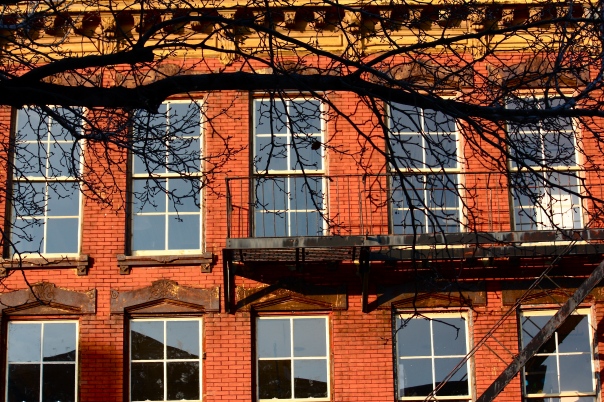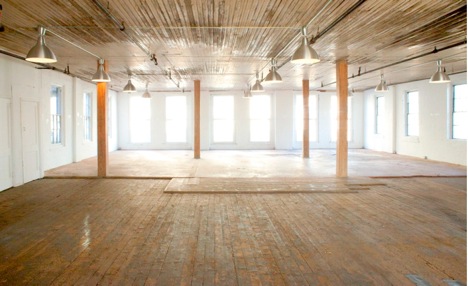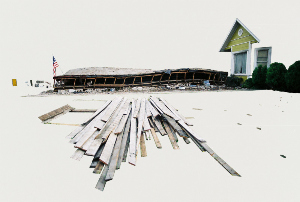 Location, location, location! It's a real estate mantra, but it's also the heart of an up-and-coming art world love affair, a show resulting from a ménage-à-trois among three curators and a building. The place is a one-year-old gallery, The Invisible Dog. In November of 2008, the major question for most New York art galleries was survival. But this was also the month Lucien Zayan stumbled upon the abandoned factory at 51 Bergen Street,
Location, location, location! It's a real estate mantra, but it's also the heart of an up-and-coming art world love affair, a show resulting from a ménage-à-trois among three curators and a building. The place is a one-year-old gallery, The Invisible Dog. In November of 2008, the major question for most New York art galleries was survival. But this was also the month Lucien Zayan stumbled upon the abandoned factory at 51 Bergen Street, ![]() three stories high and still crammed full of belts, jewelry, and, of course, that 70's fad, invisible dog leashes.
three stories high and still crammed full of belts, jewelry, and, of course, that 70's fad, invisible dog leashes.
Zayan, a then 43-year-old French theatre producer, was only in New York on vacation. Six months later, he had moved to Brooklyn, with a visa and a deal with the building's owners. Six months after that, he was open for business.
"I fell in love with the building. It's my real love story here," says Zayan.
The whirlwind romance may sound like the sort of whim available only to the independently wealthy. However, Zayan was anything but. The gallery's start-up capital came from the former factory's leftover inventory, which the building owners had gifted Zayan with the lease, and that he then sold in a flea market on the ground floor.
Zayan's business plan for his art gallery is a lot like the concept of an invisible dog leash―the actual shows, just like the dog, aren't necessary. The income for the space comes from the second-floor studios Zayan rents to artists, as well as events from cook-offs to fashion shows. This savvy idea of an arrangement―which was Zayan's winning card with the building's owners―gives him the freedom to choose only the art shows that move him.

"I'm not an artist, I'm a curator. I have to curate the building." This way, he can share with the general public the enchantment he felt from the very first day.
What better place, then, for the latest show by Recession Art, which is all about the magic of location?
Co-founded by sisters Emma and Ani Katz, Recession Art's mission is to connect emerging artists with emerging collectors. The surroundings of the Boerum Hill neighborhood, and the white brick, window, and rough wood interior of the gallery itself, frame this collection almost too perfectly for its target audience. Who better than emerging Brooklynites?
"Affordable art doesn't have to come from Ikea," explains Emma Katz, who is the small group's managing director. Her mission was, in part, inspired by the empty walls of the Brooklyn apartment she and her boyfriend purchased a few years ago. 
"What is the Where?" curated by Recession Art's first guest curator, Risa Shoup, is the young arts organization's third show at The Invisible Dog. But it's the first that directly explores the way art is affected by its surroundings.
However, if you are not a nearby resident, this show, which runs until November 21, is worth a trip. The collection is unusually strong. Each artist has played on the theme of location, but the pieces don't depend on the show's concept for attention. Still, the poetry of it lends the collection a bittersweet aftertaste that lingers longer than its images.
"My whole adult life―whatever that means―" jokes Shoup, who is only 27, "I've been obsessed with the relationship between location, identity, and perception."
Her concept for this show beat out half a dozen other candidates for the position. Shoup admits that the intensity of her interest came from growing up in the homogeneous insularity of the suburbs. "It was being queer, but it was also just being different."
But embracing her identity and the people it has brought into her life has proved fruitful. It was Shoup's girlfriend, Diana Glazer, who came across Recession Art's search for a curator. It was also Glazer who introduced me to Shoup and turned me on to her work.
Shoup's personal experiences, though, were only a jumping off point for the show. And her artists have attacked the question of environment in very different ways.
Lawrence Mesich's "At Work" is the most playful in its dealings with location. The piece is made up of aluminum pipes attached to five ducts, each with a different video inside of a man at a mundane job. Peering through the ducts gives the 90's-movie pleasure of spying through the ventilation system. Meanwhile, there's a meta-pleasure added by the gallery's actual ventilation system, which crawls up the same wall.

Ian Addison Hall's photographic collages, on the other hand, create a haunting dream world. Hall has arranged 35mm cut-outs against drab beige backgrounds, nailing the essence of each location in a minimum of images, like a photographic haiku. There are no walls, only angles and perspective--windows and doorways gaping into nowhere.
Each of the fifteen different artists included in the show has been given generous space within the 4,000 square foot loft. Shoup's desire with "What is the Where" was to create an environment that allows observers to absorb the works of art and form their own opinions. Though by 9pm the place is densely full, it doesn't feel cramped. A DJ set up by the door underscores the party without music, just an ambient rhythm. The mood is festive but laid back. The crowd ranges from plaid shirts, facial hair, and draping sweaters, to colorful dresses and sports coats. Even the five-and-under have a few representatives running around.
"The thing that would break my heart," says Shoup, "is if someone walked up to me and said I really don't feel welcome here."
Moments later, Shoup has disappeared into the crowd. Zayan and the Katz sisters are also hidden among the throngs of people. From the doorway to the stairs, all I can see are the walls of the gallery pulling all of them together, the leash around the dog.
What is the Where?: A Recession Art Show
November 13-21, 2010
The Invisible Dog Art Center, 51 Bergen Street